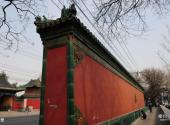
Scenic spot introduction:
The Imperial Temple of the Past Dynasties in Beijing is a royal temple with Fuxi, Yan and Huang ancestors as the center of worship, and a unified multi-ethnic series of emperors and the names of heroes from past dynasties as the worship system. It is commonly known as the Imperial Temple. The Imperial Temple is located on the north side of Fuchengmen Neijie Road in Xicheng District, Beijing. It was the place where the emperors of the Ming and Qing dynasties worshiped their ancestors. Its political status is the same as that of the Taimiao Temple and the Confucius Temple. They are collectively known as the three major royal temples in Beijing during the Ming and Qing Dynasties. Today's Imperial Temple, as a masterpiece in the treasure house of ancient Chinese architecture, is an important cultural place that attracts Chinese at home and abroad to worship their ancestors, praise their ancestors, and enhance their sense of historical pride and national cohesion.Attractions distribution:
The original site of the imperial temples of the past dynasties was Baoan Temple. It was rebuilt in the ninth year of Jiajing in the Ming Dynasty (1530), completed in the tenth year of Jiajing in the Ming Dynasty (1531), and rebuilt in the seventh year of Yongzheng in the Qing Dynasty (1729). The entire building complex faces south and faces north, covering an area of 21,500 square meters. , the ancient building covers an area of 6,000 square meters, and is arranged in depth along the central axis. From south to north are the screen wall, temple gate, Jingde Gate, Jingdezhong Temple, and sacrificial vessel storehouse. On both sides of the central axis are the east and west side halls, The stele pavilion, the furnace, the bell tower; the southeast side has the divine kitchen, the divine storehouse, the slaughtering pavilion, and the well pavilion; the southwest side has the music and dance deacon's room, the codekeeper's room, the fasting dormitory room, and the "temple within the temple" Guandi Temple. The layout is magnificent and of royal quality, making it a masterpiece of ancient Chinese architecture.The emperors of the Ming and Qing dynasties worshiped the emperors and founding heroes of the country here. After several adjustments, Qianlong finally determined the number of emperors to be worshiped as 188, and put forward the view that "the unification of China will never be disconnected". In the 380 years from the 11th year of Jiajing in the Ming Dynasty to the end of the Qing Dynasty, a total of 662 sacrificial ceremonies were held in the temples of emperors in the past dynasties. After the Republic of China, the sacrifices in the Imperial Temple were stopped and were used by the education department instead. After the founding of the People's Republic of China, the temple was used by Beijing No. 3 Girls' Middle School, which was later renamed Beijing No. 159 Middle School. In 2000, governments at all levels allocated funds for the three-year renovation, and it was officially opened to the public in April 2004.
Scenic spot qualifications:
National 2A-level scenic spotScenic spot features:
Cultural tours, historical tours, temples, museumsAttraction Address
Travel Guide
Best time to visit:
All seasons
Tourist Transportation
Scenic spot location:
China > Beijing > Xicheng District
How to get there:
From downtown Beijing, take bus No. 101, 102, 103, 13, 42, 409, 603, 709, 812, 814, 823, 846, 850 and get off at Baitasi Station.
Scenic area map:
Click to expand the scenic area map
Attraction Tickets
Imperial Temple ticket price:
20 yuan/person
Scenic area opening hours:
Peak season 7:30-16:30
Low season 8:00-16:00
Closed every Tuesday.














